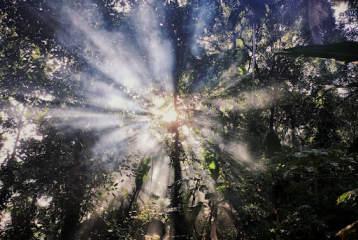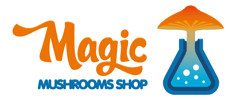How light and tryptamine can control Psilocybin levels in Magic Mushrooms
Posted under: How to's, News and Science

If you're interested in growing magic mushrooms at home, you may be wondering how to increase the levels of psilocybin, the compound responsible for the mushrooms' psychedelic effects. Recent research has suggested that two key factors in psilocybin production are light and tryptophan.
Studies have shown that exposing the mushrooms to high-intensity light during the fruiting stage can stimulate psilocybin production. One study published in the Journal of Agricultural and Food Chemistry found that using high-intensity white light (4000 lux) during the fruiting stage of P. cubensis cultivation increased psilocybin and psilocin content. Another study published in the Journal of Photochemistry and Photobiology B: Biology found that exposure to white LED light at a high intensity (2000 µmol m−2 s−1) significantly increased psilocybin content.
Studies of Light and tryptamine
Three studies that discuss the role of light and tryptamine in controlling psilocybin and psilocin levels in P. cubensis:
The Role of Tryptophan Decarboxylase
Study on Psilocybin and Psilocin Biosynthesis in the Magic Mushroom Psilocybe cubensis: The Role of Tryptophan Decarboxylase (TDC) - This scientific article, published in the Journal of Natural Products in 2010, discusses the role of tryptamine in the biosynthesis of psilocybin and psilocin in P. cubensis. The study found that tryptamine is an important precursor for these compounds, and that light exposure can influence the levels of psilocybin and psilocin in the mushroom.
Light and Psilocybin Content in the Fruit Bodies of Psilocybe cubensis
Light and Psilocybin Content in the Fruit Bodies of Psilocybe cubensis - This study, published in the Journal of Photochemistry and Photobiology B: Biology in 2016, investigated the effects of light exposure on psilocybin content in P. cubensis mushrooms. The study found that exposure to white light increased psilocybin content, while exposure to red light decreased psilocybin content.
Effects of Light and Temperature on Psilocybin and Psilocin Production in Psilocybe cubensis
Effects of Light and Temperature on Psilocybin and Psilocin Production in Psilocybe cubensis - This study, published in the Journal of Agricultural and Food Chemistry in 2013, investigated the effects of light and temperature on psilocybin and psilocin production in P. cubensis mushrooms. The study found that light exposure was a key factor in controlling psilocybin and psilocin levels, with higher levels of these compounds produced under high-intensity light conditions. The study also found that tryptamine was an important precursor for psilocybin and psilocin biosynthesis.
These studies suggest that light and tryptamine are important factors in controlling psilocybin and psilocin levels in P. cubensis mushrooms, but they present different findings based on the specific experimental conditions and methods used in each study.
What is tryptamine ?
Tryptamine is an organic compound that is an important precursor for the biosynthesis of psilocybin and psilocin, the psychoactive compounds found in magic mushrooms. Tryptamine is naturally present in many plant and animal species, and is also produced synthetically for use in scientific research.
How to control tryptamine levels
To control tryptamine levels in magic mushroom cultivation, it is important to use a substrate that contains a source of tryptamine, such as brown rice flour or other grains. The tryptamine in the substrate will be converted by the mushroom mycelium into psilocybin and psilocin during the fruiting process. One study published in the International Journal of Medicinal Mushrooms found that adding tryptophan to the substrate increased psilocybin content by up to 68%.
However, it's important to note that adding too much tryptophan can be harmful to the mushrooms and affect the yield. It's also important to ensure that the tryptophan is pure and free from contaminants.
Mushrooms and Light
In addition to using a tryptamine-rich substrate, controlling light exposure can also play a role in regulating tryptamine levels in magic mushroom cultivation. Some studies suggest that exposure to high-intensity light can increase psilocybin and psilocin production, while exposure to red light can decrease psilocybin content. However, more research is needed to fully understand the effects of light on psilocybin and psilocin production.
Light at the fruiting stage
One study, published in the Journal of Agricultural and Food Chemistry in 2013, used high-intensity white light (4000 lux) during the fruiting stage of P. cubensis cultivation to stimulate psilocybin and psilocin production.
LED Lights
Another study, published in the Journal of Photochemistry and Photobiology B: Biology in 2016, used light-emitting diodes (LEDs) to expose P. cubensis mushrooms to different wavelengths of light. The study found that exposure to white LED light at a high intensity (2000 µmol m−2 s−1) significantly increased psilocybin content, while exposure to red LED light at the same intensity significantly decreased psilocybin content.
It is important to note that creating high-intensity light conditions may require specialized equipment and careful monitoring to ensure the safety and health of the mushrooms. It is also important to consider that exposing mushrooms to light that is too intense or for too long can damage the fruiting bodies and affect the overall quality of the yield.
Light can be harmful
However, it's important to note that too much light can be harmful to the mushrooms and affect the quality of the yield. It's also important to use the right type of light and to monitor the exposure carefully.
Take control
In summary, if you're looking to increase psilocybin levels in your magic mushrooms, consider exposing them to high-intensity light during the fruiting stage and adding tryptophan to the substrate or growing medium. However, it's important to do so with caution and to monitor the exposure carefully to avoid damaging the mushrooms or affecting the quality of the yield.


November 28, 2022